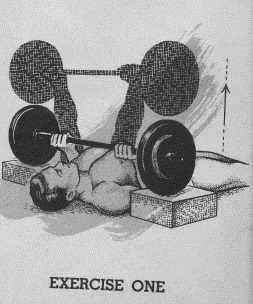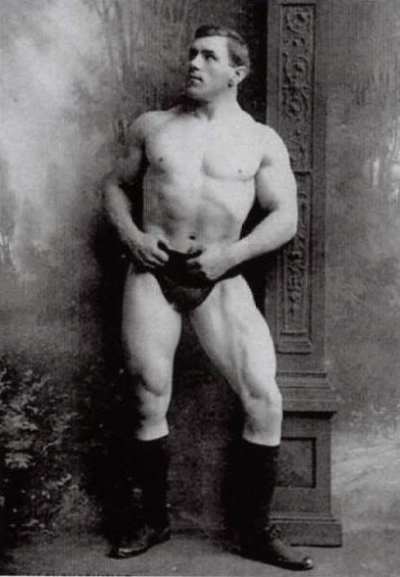Rule for the Hackenschmidt Floor Press
by Al Myers
Coming up in January on the USAWA Meet Schedule will be the Dino Gym Challenge – featuring a meet of Old Time Strongman Lifts. We are now into our third year of OTSM being offered by the USAWA, and I see that it is gaining momentum. This years meet at the Dino Challenge will include three OTSM lifts that closely mimic the three powerlifts. The lifts are two that have been contested within the past year (Anderson Squat & Peoples Deadlift), plus a new exhibition lift – the Hackenschmidt Floor Press. This new lift is viewed by the USAWA as an exhibition lift – meaning that it is an unofficial lift thus no USAWA records may be set or established in it. However, the USAWA rules DO ALLOW exhibition lifts to be counted in the meet scoring (Section VIII.11), thus it can legally be part of the competition. I have been working with the USAWA Old Time Strongman Chairman Thom Van Vleck on establishing an unofficial rule for the Hackenschmidt Floor Press that will be used at the Dino Challenge, and this is what we have worked up:
Hackenschmidt Floor Press
A chest press (with a standard Olympic bar) will be performed while lying flat on the floor/platform. The bar height, measured to the bottom of the bar from the platform, can be no greater than 15”. The bar/plates may rest on blocks or supports to achieve this height. The lift starts when the lifter, while lying under the bar with the bar above the chest, starts to press. A time limit of 1 minute is given for each attempt, meaning the lifter may reset as many times as necessary within this time limit to complete a legal lift. The lift is complete when the bar is pressed completely with the lifter’s elbows locked out. It is not an infraction to press unevenly, lock out at different times, raise the head, or allow the bar to lower during a part of the press. It is an infraction if the hips/legs rise off the floor/platform during any part of the lift. Once complete, an official will give a command to end the lift.
As you can see, this is a partial floor press since the bar height is set at 15 inches. There has been an interesting discussion in the USAWA Discussion Forum regarding the development of this lift, and Thom and I have taken those comments into consideration in writing this rule. A little over a year ago I wrote a blog outlining some of the “founding principles” of OTSM in the USAWA. I don’t want to repeat all that here again, but here is the link for anyone who is interested – https://www.usawa.com/old-time-strongman/ Again, I want to emphasize that this is an unofficial lift and rule as of now. I really think it is important that new lifts be tried in competition as exhibition lifts first before they are proposed for official lift status. This allows a thorough competition evaluation of them, and if there are any “bugs in them” the rules can be fine-tuned before being presented to the Executive Board for an approval vote. Think of it as a “trial-run”.
Now why is this floor press named the Hackenschmidt Floor Press?
I’m sure that question is being asked by some of you reading this. George “The Russian Lion” Hackenschmidt was a famous Russian strongman and wrestler who also had remarkable ability in weightlifting. He also went by the nickname of “Hack”, which has been used in the name of another popular All Round Lift – the Hack Lift. Most feel that the Hack Lift was named after George Hackenschmidt, but from what I have read I don’t think that is the case. The name Hack comes from the German word “Hacke”, which means heels. Thus I believe the Hack Lift originated by this name terminology, as the “lift done with the bar at the heels”, aka Hacke Lift. However, Hackenschmidt was quite good at this movement and undoubtedly his name has some bearing on the legacy of this lift. But I’m getting off-topic here. Another exercise that Hackenschmidt excelled at was the floor press. At the time pressing a weight this way was not popular at all, as a press was meant for overhead lifting. This was in the days long before a bench was used to press from the chest. If you wanted to press from the chest, you had to first bring the bar to the chest while lying on the platform, thus the origin of the Pullover and Press. As most know, the pullover in this lift can sometimes be the hardest part, and definitely after that exertion the amount of weight that can be pressed is decreased. Hackenschmidt was ahead of the times here. According to David Willoughby in his famous book The Super Athletes Hackenschmidt performed the pullover and press using OVERSIZED plates, thus diminishing the effects of the pullover since the bar would come into position easier with these big plates. I would say that qualifies him as the inventor of the Floor Press as we know it, and well-deserving to have this OTSM lift named after him. His best lift was 361.5 pounds, which was claimed as a WORLD RECORD for over 18 years!!

